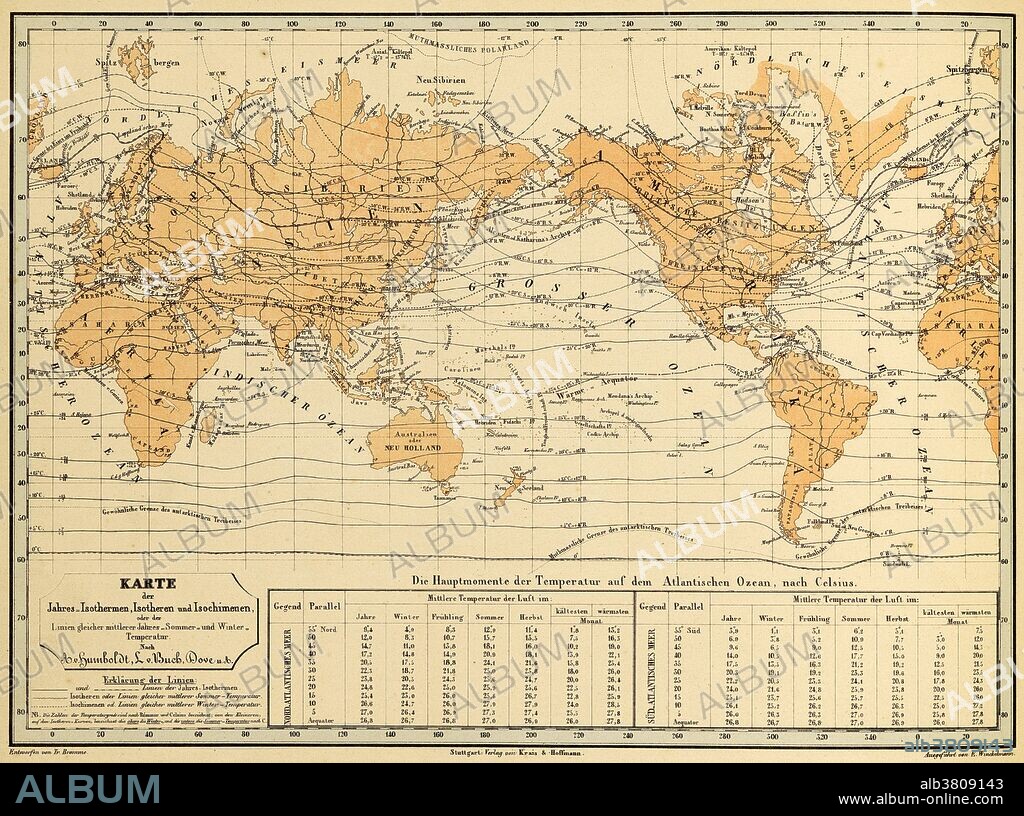alb3809143
Isothermal Map, Alexander von Humboldt, 19th C

|
Añadir a otro lightbox |
|
Añadir a otro lightbox |



¿Ya tienes cuenta? Iniciar sesión
¿No tienes cuenta? Regístrate
Compra esta imagen.
Selecciona el uso:

Título:
Isothermal Map, Alexander von Humboldt, 19th C
Descripción:
Traducción automática: Mapa isotérmico del mundo tomado del Kosmos de Alexander von Humboldt. Humboldt (1769-1859), quien inventó el uso de las isotermas, fue un geógrafo, naturalista y explorador prusiano. Su trabajo cuantitativo sobre geografía botánica sentó las bases para el campo de la biogeografía. Entre 1799 y 1804, Humboldt viajó extensamente por América Latina, explorándola y describiéndola por primera vez de una manera generalmente considerada como un punto de vista científico moderno. Su descripción del viaje fue escrita y publicada en una enorme serie de volúmenes a lo largo de 21 años. Fue uno de los primeros en proponer que alguna vez se unieran las tierras ribereñas del Océano Atlántico (América del Sur y África en particular). Posteriormente, su obra en cinco volúmenes, Kosmos (1845), intentó unificar las distintas ramas del conocimiento científico. Pensó que se necesitaba un enfoque de la ciencia que pudiera dar cuenta de la armonía de la naturaleza entre la diversidad del mundo físico.
Isothermal map of the world from Alexander von Humboldt's Kosmos. Humboldt (1769-1859), who invented the use of isotherms, was a Prussian geographer, naturalist and explorer. His quantitative work on botanical geography laid the foundation for the field of biogeography. Between 1799 and 1804, Humboldt travelled extensively in Latin America, exploring and describing it for the first time in a manner generally considered to be a modern scientific point of view. His description of the journey was written up and published in an enormous set of volumes over 21 years. He was one of the first to propose that the lands bordering the Atlantic Ocean were once joined (South America and Africa in particular). Later, his five-volume work, Kosmos (1845), attempted to unify the various branches of scientific knowledge. He thought an approach to science was needed that could account for the harmony of nature among the diversity of the physical world.
Crédito:
Album / Science Source / Wellcome Images
Autorizaciones:
Modelo: No - Propiedad: No
¿Preguntas relacionadas con los derechos?
¿Preguntas relacionadas con los derechos?
Tamaño imagen:
5384 x 4012 px | 61.8 MB
Tamaño impresión:
45.6 x 34.0 cm | 17.9 x 13.4 in (300 dpi)
Palabras clave:
ARTE • ATLAS • CARTOGRAFIA • GEOGRAFIA • GEOLOGIA • HISTORIA • HISTORICO • ILUSTRACION • MAPA DEL MUNDO • MAPA MUNDI • MAPA • MAPAMUNDI • OBRA DE ARTE • SIGLO XIX • SISTEMA • VON HUMBOLDT
 Pinterest
Pinterest Twitter
Twitter Facebook
Facebook Copiar enlace
Copiar enlace Email
Email
